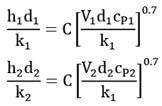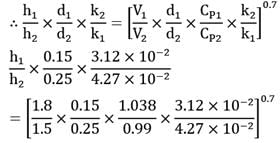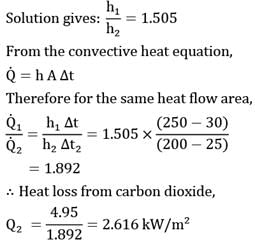Mechanical Engineering Exam > Mechanical Engineering Questions > Air flows at 1.8 m/s past a 15 cm diameter pi...
Start Learning for Free
Air flows at 1.8 m/s past a 15 cm diameter pipe in a direction normal to the axis. The pipe surface is at 30°C and it receives 4.95 kW/m2 of heat from the air at 250°C temperature. The convective heat transfer coefficient is prescribed by the relation.

Under similar operating conditions, make calculations for the heat loss from carbon dioxide at 200°C when it flows at 1.5 m/s normal to a 25 cm diameter pipe at 25°C.
The relevant thermo-physical properties for air and carbon dioxide are For air at 250°C
cP = 1.038 kJ/kgK
k = 4.270 x 10-2 W/mK
For CO2 at 200°C
cP = 0.99 kJ/kgK
k = 3.12 x 10-2 W/mK
Predict your answer in kW/m2 correct upto two decimal places.

Under similar operating conditions, make calculations for the heat loss from carbon dioxide at 200°C when it flows at 1.5 m/s normal to a 25 cm diameter pipe at 25°C.
The relevant thermo-physical properties for air and carbon dioxide are For air at 250°C
cP = 1.038 kJ/kgK
k = 4.270 x 10-2 W/mK
For CO2 at 200°C
cP = 0.99 kJ/kgK
k = 3.12 x 10-2 W/mK
Predict your answer in kW/m2 correct upto two decimal places.
Correct answer is between '2.60,2.65'. Can you explain this answer?
| FREE This question is part of | Download PDF Attempt this Test |
Verified Answer
Air flows at 1.8 m/s past a 15 cm diameter pipe in a direction normal ...
Left suffix 1 denotes air and suffix 2 denote carbon dioxide. Then,






Most Upvoted Answer
Air flows at 1.8 m/s past a 15 cm diameter pipe in a direction normal ...
Left suffix 1 denotes air and suffix 2 denote carbon dioxide. Then,






Attention Mechanical Engineering Students!
To make sure you are not studying endlessly, EduRev has designed Mechanical Engineering study material, with Structured Courses, Videos, & Test Series. Plus get personalized analysis, doubt solving and improvement plans to achieve a great score in Mechanical Engineering.

|
Explore Courses for Mechanical Engineering exam
|

|
Similar Mechanical Engineering Doubts
Air flows at 1.8 m/s past a 15 cm diameter pipe in a direction normal to the axis. The pipe surface is at 30°C and it receives 4.95 kW/m2 of heat from the air at 250°C temperature. The convective heat transfer coefficient is prescribed by the relation.Under similar operating conditions, make calculations for the heat loss from carbon dioxide at 200°C when it flows at 1.5 m/s normal to a 25 cm diameter pipe at 25°C.The relevant thermo-physical properties for air and carbon dioxide areFor air at 250°CcP = 1.038 kJ/kgKk = 4.270 x 10-2 W/mKFor CO2 at 200°CcP = 0.99 kJ/kgKk = 3.12 x 10-2 W/mKPredict your answer in kW/m2 correct upto two decimal places.Correct answer is between '2.60,2.65'. Can you explain this answer?
Question Description
Air flows at 1.8 m/s past a 15 cm diameter pipe in a direction normal to the axis. The pipe surface is at 30°C and it receives 4.95 kW/m2 of heat from the air at 250°C temperature. The convective heat transfer coefficient is prescribed by the relation.Under similar operating conditions, make calculations for the heat loss from carbon dioxide at 200°C when it flows at 1.5 m/s normal to a 25 cm diameter pipe at 25°C.The relevant thermo-physical properties for air and carbon dioxide areFor air at 250°CcP = 1.038 kJ/kgKk = 4.270 x 10-2 W/mKFor CO2 at 200°CcP = 0.99 kJ/kgKk = 3.12 x 10-2 W/mKPredict your answer in kW/m2 correct upto two decimal places.Correct answer is between '2.60,2.65'. Can you explain this answer? for Mechanical Engineering 2024 is part of Mechanical Engineering preparation. The Question and answers have been prepared according to the Mechanical Engineering exam syllabus. Information about Air flows at 1.8 m/s past a 15 cm diameter pipe in a direction normal to the axis. The pipe surface is at 30°C and it receives 4.95 kW/m2 of heat from the air at 250°C temperature. The convective heat transfer coefficient is prescribed by the relation.Under similar operating conditions, make calculations for the heat loss from carbon dioxide at 200°C when it flows at 1.5 m/s normal to a 25 cm diameter pipe at 25°C.The relevant thermo-physical properties for air and carbon dioxide areFor air at 250°CcP = 1.038 kJ/kgKk = 4.270 x 10-2 W/mKFor CO2 at 200°CcP = 0.99 kJ/kgKk = 3.12 x 10-2 W/mKPredict your answer in kW/m2 correct upto two decimal places.Correct answer is between '2.60,2.65'. Can you explain this answer? covers all topics & solutions for Mechanical Engineering 2024 Exam. Find important definitions, questions, meanings, examples, exercises and tests below for Air flows at 1.8 m/s past a 15 cm diameter pipe in a direction normal to the axis. The pipe surface is at 30°C and it receives 4.95 kW/m2 of heat from the air at 250°C temperature. The convective heat transfer coefficient is prescribed by the relation.Under similar operating conditions, make calculations for the heat loss from carbon dioxide at 200°C when it flows at 1.5 m/s normal to a 25 cm diameter pipe at 25°C.The relevant thermo-physical properties for air and carbon dioxide areFor air at 250°CcP = 1.038 kJ/kgKk = 4.270 x 10-2 W/mKFor CO2 at 200°CcP = 0.99 kJ/kgKk = 3.12 x 10-2 W/mKPredict your answer in kW/m2 correct upto two decimal places.Correct answer is between '2.60,2.65'. Can you explain this answer?.
Air flows at 1.8 m/s past a 15 cm diameter pipe in a direction normal to the axis. The pipe surface is at 30°C and it receives 4.95 kW/m2 of heat from the air at 250°C temperature. The convective heat transfer coefficient is prescribed by the relation.Under similar operating conditions, make calculations for the heat loss from carbon dioxide at 200°C when it flows at 1.5 m/s normal to a 25 cm diameter pipe at 25°C.The relevant thermo-physical properties for air and carbon dioxide areFor air at 250°CcP = 1.038 kJ/kgKk = 4.270 x 10-2 W/mKFor CO2 at 200°CcP = 0.99 kJ/kgKk = 3.12 x 10-2 W/mKPredict your answer in kW/m2 correct upto two decimal places.Correct answer is between '2.60,2.65'. Can you explain this answer? for Mechanical Engineering 2024 is part of Mechanical Engineering preparation. The Question and answers have been prepared according to the Mechanical Engineering exam syllabus. Information about Air flows at 1.8 m/s past a 15 cm diameter pipe in a direction normal to the axis. The pipe surface is at 30°C and it receives 4.95 kW/m2 of heat from the air at 250°C temperature. The convective heat transfer coefficient is prescribed by the relation.Under similar operating conditions, make calculations for the heat loss from carbon dioxide at 200°C when it flows at 1.5 m/s normal to a 25 cm diameter pipe at 25°C.The relevant thermo-physical properties for air and carbon dioxide areFor air at 250°CcP = 1.038 kJ/kgKk = 4.270 x 10-2 W/mKFor CO2 at 200°CcP = 0.99 kJ/kgKk = 3.12 x 10-2 W/mKPredict your answer in kW/m2 correct upto two decimal places.Correct answer is between '2.60,2.65'. Can you explain this answer? covers all topics & solutions for Mechanical Engineering 2024 Exam. Find important definitions, questions, meanings, examples, exercises and tests below for Air flows at 1.8 m/s past a 15 cm diameter pipe in a direction normal to the axis. The pipe surface is at 30°C and it receives 4.95 kW/m2 of heat from the air at 250°C temperature. The convective heat transfer coefficient is prescribed by the relation.Under similar operating conditions, make calculations for the heat loss from carbon dioxide at 200°C when it flows at 1.5 m/s normal to a 25 cm diameter pipe at 25°C.The relevant thermo-physical properties for air and carbon dioxide areFor air at 250°CcP = 1.038 kJ/kgKk = 4.270 x 10-2 W/mKFor CO2 at 200°CcP = 0.99 kJ/kgKk = 3.12 x 10-2 W/mKPredict your answer in kW/m2 correct upto two decimal places.Correct answer is between '2.60,2.65'. Can you explain this answer?.
Solutions for Air flows at 1.8 m/s past a 15 cm diameter pipe in a direction normal to the axis. The pipe surface is at 30°C and it receives 4.95 kW/m2 of heat from the air at 250°C temperature. The convective heat transfer coefficient is prescribed by the relation.Under similar operating conditions, make calculations for the heat loss from carbon dioxide at 200°C when it flows at 1.5 m/s normal to a 25 cm diameter pipe at 25°C.The relevant thermo-physical properties for air and carbon dioxide areFor air at 250°CcP = 1.038 kJ/kgKk = 4.270 x 10-2 W/mKFor CO2 at 200°CcP = 0.99 kJ/kgKk = 3.12 x 10-2 W/mKPredict your answer in kW/m2 correct upto two decimal places.Correct answer is between '2.60,2.65'. Can you explain this answer? in English & in Hindi are available as part of our courses for Mechanical Engineering.
Download more important topics, notes, lectures and mock test series for Mechanical Engineering Exam by signing up for free.
Here you can find the meaning of Air flows at 1.8 m/s past a 15 cm diameter pipe in a direction normal to the axis. The pipe surface is at 30°C and it receives 4.95 kW/m2 of heat from the air at 250°C temperature. The convective heat transfer coefficient is prescribed by the relation.Under similar operating conditions, make calculations for the heat loss from carbon dioxide at 200°C when it flows at 1.5 m/s normal to a 25 cm diameter pipe at 25°C.The relevant thermo-physical properties for air and carbon dioxide areFor air at 250°CcP = 1.038 kJ/kgKk = 4.270 x 10-2 W/mKFor CO2 at 200°CcP = 0.99 kJ/kgKk = 3.12 x 10-2 W/mKPredict your answer in kW/m2 correct upto two decimal places.Correct answer is between '2.60,2.65'. Can you explain this answer? defined & explained in the simplest way possible. Besides giving the explanation of
Air flows at 1.8 m/s past a 15 cm diameter pipe in a direction normal to the axis. The pipe surface is at 30°C and it receives 4.95 kW/m2 of heat from the air at 250°C temperature. The convective heat transfer coefficient is prescribed by the relation.Under similar operating conditions, make calculations for the heat loss from carbon dioxide at 200°C when it flows at 1.5 m/s normal to a 25 cm diameter pipe at 25°C.The relevant thermo-physical properties for air and carbon dioxide areFor air at 250°CcP = 1.038 kJ/kgKk = 4.270 x 10-2 W/mKFor CO2 at 200°CcP = 0.99 kJ/kgKk = 3.12 x 10-2 W/mKPredict your answer in kW/m2 correct upto two decimal places.Correct answer is between '2.60,2.65'. Can you explain this answer?, a detailed solution for Air flows at 1.8 m/s past a 15 cm diameter pipe in a direction normal to the axis. The pipe surface is at 30°C and it receives 4.95 kW/m2 of heat from the air at 250°C temperature. The convective heat transfer coefficient is prescribed by the relation.Under similar operating conditions, make calculations for the heat loss from carbon dioxide at 200°C when it flows at 1.5 m/s normal to a 25 cm diameter pipe at 25°C.The relevant thermo-physical properties for air and carbon dioxide areFor air at 250°CcP = 1.038 kJ/kgKk = 4.270 x 10-2 W/mKFor CO2 at 200°CcP = 0.99 kJ/kgKk = 3.12 x 10-2 W/mKPredict your answer in kW/m2 correct upto two decimal places.Correct answer is between '2.60,2.65'. Can you explain this answer? has been provided alongside types of Air flows at 1.8 m/s past a 15 cm diameter pipe in a direction normal to the axis. The pipe surface is at 30°C and it receives 4.95 kW/m2 of heat from the air at 250°C temperature. The convective heat transfer coefficient is prescribed by the relation.Under similar operating conditions, make calculations for the heat loss from carbon dioxide at 200°C when it flows at 1.5 m/s normal to a 25 cm diameter pipe at 25°C.The relevant thermo-physical properties for air and carbon dioxide areFor air at 250°CcP = 1.038 kJ/kgKk = 4.270 x 10-2 W/mKFor CO2 at 200°CcP = 0.99 kJ/kgKk = 3.12 x 10-2 W/mKPredict your answer in kW/m2 correct upto two decimal places.Correct answer is between '2.60,2.65'. Can you explain this answer? theory, EduRev gives you an
ample number of questions to practice Air flows at 1.8 m/s past a 15 cm diameter pipe in a direction normal to the axis. The pipe surface is at 30°C and it receives 4.95 kW/m2 of heat from the air at 250°C temperature. The convective heat transfer coefficient is prescribed by the relation.Under similar operating conditions, make calculations for the heat loss from carbon dioxide at 200°C when it flows at 1.5 m/s normal to a 25 cm diameter pipe at 25°C.The relevant thermo-physical properties for air and carbon dioxide areFor air at 250°CcP = 1.038 kJ/kgKk = 4.270 x 10-2 W/mKFor CO2 at 200°CcP = 0.99 kJ/kgKk = 3.12 x 10-2 W/mKPredict your answer in kW/m2 correct upto two decimal places.Correct answer is between '2.60,2.65'. Can you explain this answer? tests, examples and also practice Mechanical Engineering tests.

|
Explore Courses for Mechanical Engineering exam
|

|
Suggested Free Tests
Signup for Free!
Signup to see your scores go up within 7 days! Learn & Practice with 1000+ FREE Notes, Videos & Tests.
























